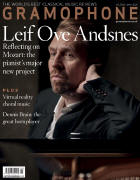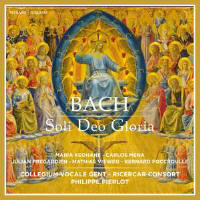Texte paru dans: / Appeared in: |
|
|
Outil de traduction (Très approximatif) |
|
|
Reviewer:
Lindsay Kemp Two church cantatas here for the weeks after Trinity: No 21 composed for Weimar in 1714 and No 76 from the first weeks of Bach’s time at Leipzig in 1723. oth are in the extended two-part form Bach sometimes liked to use in his earlier cantatas, the gain for the listener being more, often richer choruses, and an engagingly experimental and specific response to text. Part 1 of Ich hatte viel Bekümmernis mourns desertion by God in music of gorgeous plangency, struggling to find hope, before Part 2 reveals that he is still with us, the light entering in an almost amorous duet between Christ and the Soul. Die Himmel erzählen die Ehre Gottes opens in trumpet-led triumph, praising God’s greatness before dwelling on the enmity of unbelievers, defiantly promising to bear testament to Christ and then ending in calmly uplifted praise. This near narrative approach is here enhanced by the insertion after each part of an organ chorale (Bernard Foccroulle playing the instrument of the Temple du Bouclier in Strasbourg) that reflects the mood of the moment: BWV639, for instance, is weary but stoic after Part 1 of Cantata No 21, while BWV715 makes a joyous postlude to Cantata No 76 . The expressive sensitivity Philippe Pierlot and the Ricercar Consort have shown before in Bach are here again. Prime among them is a gentleness of touch that lingers over Bach’s pressingly affecting melodies and allows them to tell their story. This makes the achingly profound first part of Cantata No 21 especially effective, though perhaps there is less definition and punch in the livelier music elsewhere than we can get from other Bach conductors. Essentially these performances are in the loving, soft-edged mould of Philippe Herreweghe (whose choir is borrowed for the ripieno choir), save that Pierlot, a gamba player, perhaps pays more attention to instrumental detail and cohesion than choral. The four main singers are well matched in consort, if slightly less even as soloists. Maria Keohane is the most striking, showing her usual power to move when the music lies high and still; Matthias Vieweg’s voice can be both blustery and tender; and Julian Prégardien shows that he has a more incisive and dramatic voice than his famous father, if less of his calm control. Some brief moments of lost focus aside, however, Pierlot’s Bach is touching and humane. |
|




